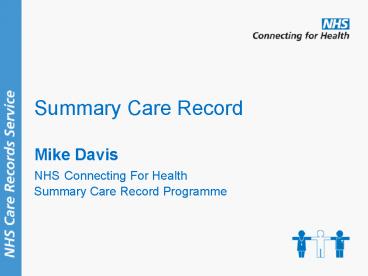Summary Care Record - PowerPoint PPT Presentation
1 / 12
Title:
Summary Care Record
Description:
... allegedly looking at Hollywood star George Clooney's ... Enables patients to access their Summary Care Record. Patients can view their consent status ... – PowerPoint PPT presentation
Number of Views:72
Avg rating:3.0/5.0
Title: Summary Care Record
1
Summary Care Record
Mike DavisNHS Connecting For HealthSummary Care
Record Programme
2
The Summary Care Record
Strategic Objective To ensure that patients can
be confident that the NHS professionals caring
for them have reliable and rapid access, 24 hours
a day, to the relevant personal information
necessary to support their care Information
for Health, An Information Strategy for the
Modern NHS, 1998 2005, DOH
- Summary Care Record What is it
- An electronic summary of key health information
available to any NHS healthcare professional
treating a patient in England - Particularly crucial in out of hours unscheduled
care settings - It will hold limited essential information
derived from the patients electronic medical
records - Medication
- Allergies
- Significant medical history
3
The Summary Care Record
Summary Care Record Vision The NHS Summary Care
Record will support unscheduled care settings,
providing information to support care where no
information is currently held about a patient,
for example in emergency departments, primary
care out-of-hours settings, treating temporary
residents, and emergency admissions to secondary
care.
- Principles
- Will remain a Summary Record
- Contains only significant aspects of a persons
care - Accumulates new key items of the persons care as
time goes by - Derived from records of organisations delivering
care to that patient - Initially populated by General Practice
contribution - Patients can see the record via HealthSpace
4
What about all the controversy?
- Can patients refuse to have a summary?
- Yes !
- Can patients change their minds at any stage?
- Yes!
- Can patients limit what is shared?
- Yes!
5
Populating the Record
- Implied consent model
- Public information leaflet to patients with
plenty of notice of what is happening and their
options - Opportunity to find out more and refuse to have
SCR if that is their wish - Letters customised and sent to every adult over
16 - Dedicated Care Records Service Information Line
- Local Information Centres for more information
and demonstrations - Local input into voluntary organisations and
difficult to reach communities
6
Accessing the Record
- All access is governed by Role Based Access
- Controls through Smartcards
- Out of Hours
- Ensuring smooth access to SCR in busy settings
- A/E
- As critical mass of patients on line enabling
access - Community Settings
- Enabling mobile access to SCR with IG controls
- Caldicott Guardians
- Ensuring that the tools provided for them are
appropriate for their needs
7
Professional and contractual controls
Clooney hospital punishes staff
"We believe this is a harsh penalty and an
overreaction" Jeanne Oterson, spokeswoman for
the Health Professionals and Allied Employees
Union
8
HealthSpace
- Secure website for patients to record their own
health information - Enables patients to access their Summary Care
Record - Patients can view their consent status
- Resultant change in dynamic of service delivery
- Potential of coded entries to hyperlink to
knowledge support and leaflets - Partnership between patients and clinicians in
management of care
9
The Early Adopter Programme
- Six Primary Care Trusts engaged totalling 2
Million potential records - 10 technology
- 90
- Business change
- Understanding
- Growing in confidence
- Independent Evaluation by University College
London
10
Patient Feedback
- 500,000 patients mailed so far and over 100,000
records loaded to the Spine - Information Line and Information Centres were
quiet - 0.60 of patients do not want a Summary Care
Record - Most patients thought that electronic sharing was
already in place and want the NHS to get on with
it - Main area of concern was security but patients
satisfied with controls in place - Patients very keen on accessing their records
through HealthSpace
11
See the System in Action
- Workshop session before and after lunch providing
a walkthrough of the system - HealthSpace demonstration
- QA on the Summary Care Record
12
Thank You
Mike DavisNHS Connecting For HealthSummary Care
Record Programme









![[PDF] READ Free My Dog's Health & Medical Record Book Log: 6'x9' Canin PowerPoint PPT Presentation](https://s3.amazonaws.com/images.powershow.com/10083611.th0.jpg?_=20240723062)





















